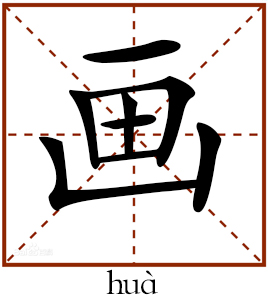Painting

When used as a noun, this character refers to a drawing, painting or picture; when used as a verb, it means “to draw, paint or sign.”
雪暗凋旗画
xuě àn diāo qí huà
Xue refers to snow and an means “dark.” Diao, which originally meant for a plant to wither, in this expression indicates that colors become pale or somber. Qi hua refers to the pattern on a flag.
This is a line from the poem, “Following the Army to the Frontier,” by the Tang poet Yang Jiong (c. 650–693). This poem tells a story of an intellectual giving up intellectual pursuits for a military career as a way to contribute to his country. “Flaring beacons relayed the alarm to the West Capital,/The scholar was filled with an ardent fighting spirit./ Holding the tally of command the general bade adieu to the palace,/ And soon the iron cavalry besieged the Dragon City./ Army flags faded and dulled in the whirling snow,/ While howling winds were punctured by battle drums./ Better to join the army and be a captain/ Than remain a scholar wallowing in books.”
From 679 to 681, the northwestern border areas of the Tang Empire were frequently harassed by the Tujue, leading to a series of military campaigns against the Tujue army. It is generally believed that the poem was inspired by the military expedition led by the Tang general Pei Xingjian.
By focusing on the most significant moments, Yang compressed the whole process of an intellectual joining the army to fight for his country into one short poem. Rather than direct description, Yang used nouns as important symbols to set the mood, filling the poem with striking imagery. For example, flares from the warning beacons send the signal of war, which is the cause of the whole event; the tally of command, which was usually separated into two pieces, one held by the emperor, the other given to a military commander as a symbol of imperial authority and ability to command troops, symbolizes the start of the expedition. The iron cavalry (the Tang army) arriving at the Dragon City (the headquarter of the Tujue) indicates that the lightning speed of the Tang troops knocked the enemy off balance.
edited by REN GUANHONG
